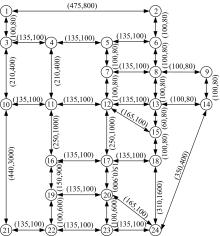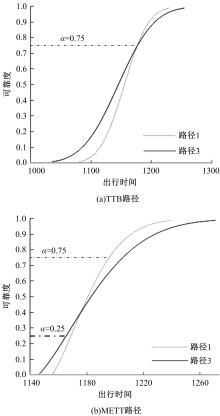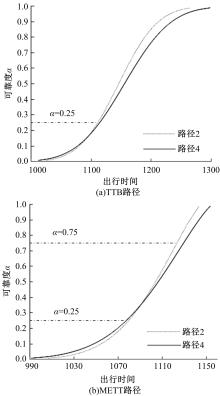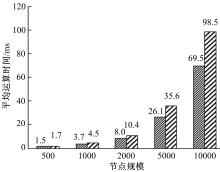Journal of Jilin University(Engineering and Technology Edition) ›› 2019, Vol. 49 ›› Issue (3): 720-726.doi: 10.13229/j.cnki.jdxbgxb20171143
Previous Articles Next Articles
Finding shortest path considering traveler′s risk attitude
Qiang TU1( ),Lin CHENG1(
),Lin CHENG1( ),Fen LIN2,Chao SUN1
),Fen LIN2,Chao SUN1
- 1. School of Transportation, Southeast University, Nanjing 210096, China
2. Shanghai Municipal Engineering Design Institute Group Co. , Ltd. , Shanghai 200092, China
CLC Number:
- U491.1
| 1 | 赵宏伟,刘宇琦,董立岩,等. 智能交通混合动态路径优化算法[J]. 吉林大学学报:工学版,2018,48(4):1214⁃1223. |
| Zhao Hong⁃wei Liu Yu⁃qi Dong Li⁃yan,et al. Dynamic route optimization algorithm based on hybrid in ITS[J]. Journal of Jilin University(Engineering and Technology Edition), 2018,48(4):1214⁃1223. | |
| 2 | 周熙阳,杨兆升,张伟,等.考虑干线协调控制的城市最优路径搜索算法[J]. 吉林大学学报:工学版,2016,46(6):1799⁃1806. |
| ZhouXi⁃yang, YangZhao⁃sheng, ZhangWei,et al. Urban shortest path searching algorithm considering coordinate control of arterial intersections[J]. Journal of Jilin University(Engineering and Technology Edition), 2016,46(6):1799⁃1806. | |
| 3 | 杜牧青,程琳. 最短路径Auction算法及其在路径诱导中的应用[J]. 武汉理工大学学报,2012,12(36):1161⁃1165. |
| DuMu⁃qing, ChengLin. Auction algorithm for shortest paths and its application in route guidance[J]. Journal of Wuhan University of Technology, 2012, 12(36): 1161⁃1165. | |
| 4 | ChenA, ZhouZ. The α⁃reliable mean⁃excess traffic equilibrium model with stochastic travel times[J]. Transportation Research Part B: Methodological, 2010, 44(4): 493⁃513. |
| 5 | ChenA,ZhaoJ.Path finding under uncertainty[J].Journal of Advanced Transportation,2005,39(1):19⁃37. |
| 6 | NieY, WuX. Shortest path problem considering on⁃time arrival probability[J]. Transportation Research Part B, 2009, 43(6): 597⁃613. |
| 7 | ShaoH,LamW H K,TamM L.A reliability⁃based stochastic traffic assignment model for network with multiple user classes under uncertainty indemand[J]. Network and Spatial Economics,2006,6(3/4):173⁃204. |
| 8 | ZhangW Y, GuanW, SongL Y, et al. Alpha⁃reliable combined mean traffic equilibrium model stochastic travel times[J]. Journal of Central South University of Technology, 2013, 20(12): 3770⁃3778. |
| 9 | Miller⁃HooksE, MahmassaniH. Path comparisons for a priori and time⁃adaptive decisions instochastic, time⁃varying networks[J]. Europe Journal of Operation Research, 2003, 146(1):67⁃82. |
| 10 | SenS, PillaiR, JoshiS, et al. A mean⁃variance model for route guidance in advanced travelerinformation systems[J]. Transportation Science, 2001, 35(1): 37⁃49. |
| 11 | ChenB Y, LamW H K, SumaleeA, et al. Finding reliable shortest paths in road networks under uncertainty[J]. Networks and Spatial Economics, 2013, 13(2): 123⁃148. |
| 12 | 唐小勇,程琳. 考虑转向延误的交通网络存储结构[J]. 公路交通科技,2007,24(1):134⁃138. |
| TangXiao⁃yong, ChengLin. A representation of traffic network inclusive of node costs[J]. Journal of Highway and Transportation Research and Development, 2007, 24(1): 134⁃138. | |
| 13 | 李雄飞,张海龙,刘兆军,等. 用启发式算法求解最短路径问题[J]. 吉林大学学报:工学版,2011,41(1):182⁃187. |
| LiXiong⁃fei,ZhangHai⁃long,LiuZhao⁃jun,et al. Problem for shortest path problem based on heuristic algorithm[J]. Journal of Jilin University(Engineering and Technology Edition), 2011,41(1):182⁃187. |
| [1] | Qiao⁃wen BAI,Zhao⁃wei QU,Yong⁃heng CHEN,Shuai XIONG,Chu⁃qing TAO. Modeling on trajectories of through vehicles with an unprotected left⁃turn phase under non⁃strict priority [J]. Journal of Jilin University(Engineering and Technology Edition), 2019, 49(3): 673-679. |
| [2] | Ning⁃bo CAO,Li⁃ying ZHAO,Zhao⁃wei QU,Yong⁃heng CHEN,Qiao⁃wen BAI,Xiao⁃lei DENG. Social force model considering bi⁃direction pedestrian slipstreaming behavior [J]. Journal of Jilin University(Engineering and Technology Edition), 2019, 49(3): 688-694. |
| [3] | Lei CHEN,Jiang⁃feng WANG,Yuan⁃li GU,Xue⁃dong YAN. Multi⁃source traffic data fusion algorithm based onmind evolutionary algorithm optimization [J]. Journal of Jilin University(Engineering and Technology Edition), 2019, 49(3): 705-713. |
| [4] | Chao⁃ying YIN,Chun⁃fu SHAO,Xiao⁃quan WANG. Influence of urban built environment on car commuting considering parking availability [J]. Journal of Jilin University(Engineering and Technology Edition), 2019, 49(3): 714-719. |
| [5] | CHEN Yong-heng,LIU Fang-hong,CAO Ning-bo. Analysis of conflict factors between pedestrians and channelized right turn vehicles at signalized intersections [J]. Journal of Jilin University(Engineering and Technology Edition), 2018, 48(6): 1669-1676. |
| [6] | LIU Zhao-hui, WANG Chao, LYU Wen-hong, GUAN Xin. Identification of data characteristics of vehicle running status parameters by nonlinear dynamic analysis [J]. Journal of Jilin University(Engineering and Technology Edition), 2018, 48(5): 1405-1410. |
| [7] | LIU Xiang-yu, YANG Qing-fang, KUI Hai-lin. Traffic guidance cell division based on random walk algorithm [J]. Journal of Jilin University(Engineering and Technology Edition), 2018, 48(5): 1380-1386. |
| [8] | LUAN Xin, DENG Wei, CHENG Lin, CHEN Xin-yuan. Mixed Logit model for understanding travel mode choice behavior of megalopolitan residents [J]. 吉林大学学报(工学版), 2018, 48(4): 1029-1036. |
| [9] | CHEN Yong-heng, LIU Xin-shan, XIONG Shuai, WANG Kun-wei, SHEN Yao, YANG Shao-hui. Variable speed limit control under snow and ice conditions for urban expressway in junction bottleneck area [J]. 吉林大学学报(工学版), 2018, 48(3): 677-687. |
| [10] | WANG Zhan-zhong, LU Yue, LIU Xiao-feng, ZHAO Li-ying. Improved harmony search algorithm on truck scheduling for cross docking system [J]. 吉林大学学报(工学版), 2018, 48(3): 688-693. |
| [11] | CHEN Song, LI Xian-sheng, REN Yuan-yuan. Adaptive signal control method for intersection with hook-turn buses [J]. 吉林大学学报(工学版), 2018, 48(2): 423-429. |
| [12] | SU Shu-jie, HE Lu. Transient dynamic congestion evacuation model of pedestrian at walk traffic planning crossroads [J]. 吉林大学学报(工学版), 2018, 48(2): 440-447. |
| [13] | HOU Xian-yao, CHEN Xue-wu. Use of public transit information market segmentation based onattitudinal factors [J]. 吉林大学学报(工学版), 2018, 48(1): 98-104. |
| [14] | WANG Zhan-zhong, ZHAO Li-ying, JIAO Yu-Ling, CAO Ning-bo. Social force model of pedestrian-bike mixed flow at signalized crosswalk [J]. 吉林大学学报(工学版), 2018, 48(1): 89-97. |
| [15] | GAO Kun, TU Hui-zhao, SHI Heng, LI Zhen-fei. Effect of low visibility in haze weather condition on longitudinal driving behavior in different car-following stages [J]. 吉林大学学报(工学版), 2017, 47(6): 1716-1727. |
|











